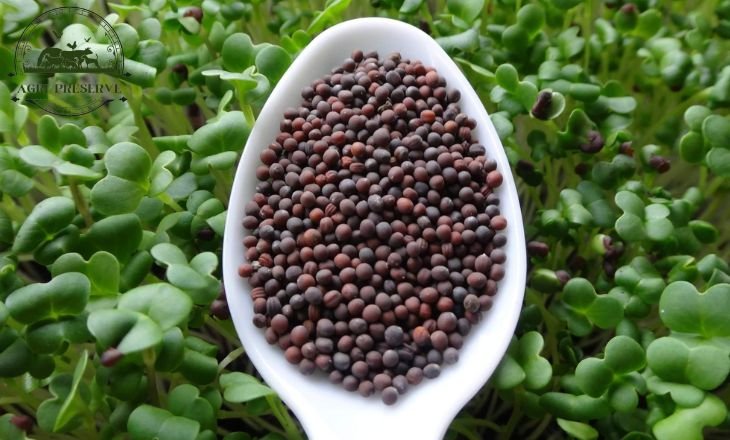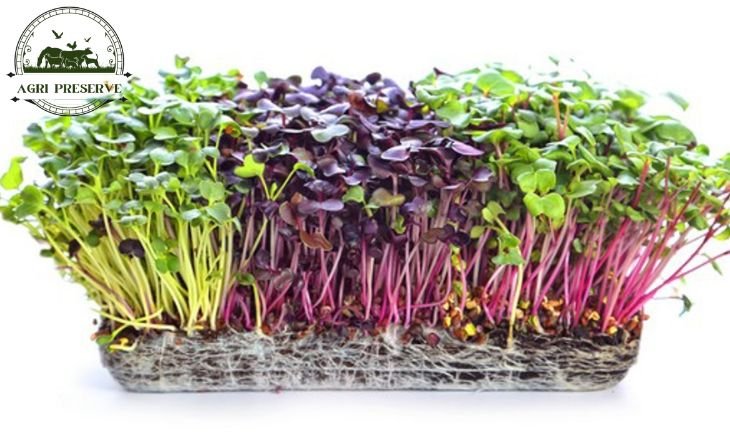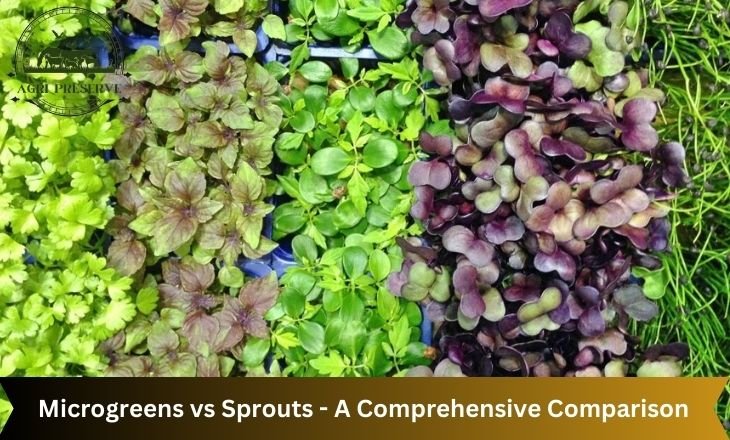Microgreens vs sprouts are both small but different. Microgreens are tiny versions of fully grown plants with solid flavours and nutrients. Sprouts are small plants just starting to grow, filled with nutrition in a compact size.
Let’s explore the differences between microgreens and sprouts to see which is better for your health.
Microgreens vs Sprouts
Microgreens and sprouts are like food superheroes, full of nutrients and flavors. But they are different. Microgreens are young plants, picked after their first true leaves show up. They have bright colors and intense flavors, from sweet to spicy, adding depth to dishes.
Sprouts are very young plants, picked before their leaves fully form. They grow in water, not soil, which makes them crunchy. While microgreens add flavor, sprouts add a fresh crunch to make meals memorable.
Both make us think more about what we eat, including taste, texture, and nutrition. They encourage us to enjoy every bite more thoughtfully.
Sprout Seeds
Sprouting seeds is an easy and effective way to maximize their nutritional benefits. You activate enzymes and enhance their nutritional value by soaking and germinating seeds. Sprouts are packed with vitamins, minerals, and antioxidants that promote good health. Adding sprouted seeds to your diet can give you a fast and efficient source of nutrients your body can absorb easily.

Microgreens Seeds
Microgreen seeds are very nutritious, containing many vitamins, minerals, and antioxidants. These small plants are harvested early, usually within 7-14 days of sprouting, making them very nutritious. Microgreen seeds have different flavors and textures, like spicy radish and earthy beetroot, which can enhance the taste of dishes.

Differences in Growth Stages
Microgreens and sprouts are not the same. Microgreens have more developed leaves and stems than sprouts. They have more decadent flavors, textures, and colors. Microgreens require more light and space to grow properly, which results in solid roots and intense flavors.
In contrast, sprouts are harvested sooner, usually after a few days. This quick growth gives sprouts a milder taste and crunchy texture, unlike the leafy profile of microgreens.
- Growth Stage Harvest Includes the Seed germination stage.
- Sprouts 2-7 days after sprouting Root, seed coat, shoot
- Microgreens 7-21 days until first true leaves First true leaves (beyond cotyledons)
Nutritional Profiles
Microgreens and sprouts are both nutritious, but they have different nutritional profiles. Microgreens are harvested later than sprouts, with more flavors and nutrients. They are rich in vitamins, minerals, and antioxidants.
Sprouts are harvested shortly after germination, full of enzymes and easy-to-digest nutrients. They have lots of protein, fibre, and essential vitamins like C and K.
Choosing between microgreens and sprouts depends on your preferences and needs. Adding these healthy foods to your diet can improve your health.
Vitamins and Minerals
The health community debates whether microgreens or sprouts are better for vitamins and minerals. Microgreens are young vegetables with many nutrients, while sprouts are germinated seeds with essential vitamins and minerals. Microgreens grow in soil, while sprouts grow in water.
Microgreens have more Vitamin C and Vitamin K, but sprouts have nutrients that are easy for the body to use. Both microgreens and sprouts are good for your health. Eating a mix of both can give you a variety of nutrients for better nutrition.
Adding microgreens and sprouts to your meals is an easy way to get more nutrients and improve your diet.
Average Vitamin Content In Sprouts And Microgreens
| Nutrient | Sprouts (Per 100g) | Microgreens (Per 100g) |
| Vitamin C | Moderate | High |
| Vitamin K | Moderate | High |
| B Vitamins | High | Higher |
Antioxidants And Enzymes
Microgreens and sprouts are tasty and healthy. They have a lot of antioxidants and enzymes that help fight off harmful substances in the body. Antioxidants like vitamin C and beta-carotene in these greens reduce stress and inflammation.
List of Key Antioxidants Found in Sprouts and Microgreens:
- Sulforaphane Chemical
- Polyphenols Supplement
- Flavonoids phytochemical
Health Considerations
Microgreens and sprouts are often overlooked but are great for adding healthy foods to your diet. Microgreens are young vegetables harvested just after the first leaves have grown, while sprouts are germinated seeds eaten whole.
Both are packed with nutrients but differ in taste, texture, and nutrition. Microgreens have a strong flavor and are good in salads, sandwiches, or smoothies.
Sprouts have a crunchy texture and mild taste that goes well with many dishes. Microgreens have more vitamins and minerals than mature vegetables, while sprouts have enzymes that help with digestion and nutrient absorption.
Microgreens or sprouts in your meals can boost your nutrient intake and support your health. Try different types and recipes to find new ways to enjoy these healthy greens.
Benefits Of Microgreens
Microgreens are packed with nutrients like vitamins, minerals, and antioxidants. Studies show that they have more of these nutrients than fully-grown vegetables. For example, red cabbage microgreens have 40 times more vitamin E and six times more vitamin C.
You can use microgreens in many dishes to add flavor and make them look nice. Chefs like using microgreens because they are healthy and make food look special.
The Benefits Of Sprouts
Sprouts are packed with nutrients that keep your body healthy. They contain vitamins, minerals, and antioxidants that strengthen your immune system. They are also rich in protein and fibre, essential for a balanced diet. Sprouts aid digestion and support gut health.
The enzymes in sprouts help break down food, reducing bloating and gas. Sprouts are an excellent option for weight management without sacrificing essential nutrients, low in calories but high in nutrients.
| Nutrients | Microgreens | Sprouts |
| Vitamins | High concentration | Varied depending on seed |
| Antioxidants | Abundant | Present |
| Enzymes | Some types | Rich in enzymatic content |
| Fiber | Depending on type | Generally good source |
Potential Risks and How to Mitigate Them
Consuming microgreens can be risky due to possible contamination during growing or harvesting. Microgreens multiply in a nutrient-rich environment, making them susceptible to bacteria if proper hygiene isn’t followed. To lower this risk, get seeds from trusted sources, use clean water for watering, and keep the growing area clean.
Sprouts also risk bacterial contamination because they grow in warm, damp conditions that are perfect for Salmonella and E. coli. To reduce this risk, wash sprouts well before eating and choose organic or locally grown types to avoid pesticides or other harmful chemicals.
| Risk Factors | Mitigation Strategies |
| Contamination | Buy from reputable sources, pay attention to recalls |
| Bacteria (Salmonella, E. coli, Listeria) | Thorough rinsing with clean water |
Key Varieties And Uses
Microgreens and sprouts offer diverse flavours and textures, making them popular for chefs and health-conscious individuals. Some key varieties of microgreens include broccoli, radish, pea shoots, and sunflower greens. These tiny greens are packed with vitamins C and K, making them a nutrient-dense addition to salads, sandwiches, and smoothies.
Types Of Microgreens
Microgreens have different tastes and health benefits. Sunflower microgreens are famous for their nutty and crunchy texture and are good in salads and sandwiches. Radish microgreens are spicy and great for adding a kick to dishes like tacos.
Pea shoots have a mild, sweet flavour like fresh peas and are rich in vitamins A, C, and folic acid. Trying various microgreens can improve your cooking and help you get more nutrients.
broccoli microgreens
Broccoli microgreens are tiny but contain nutrients like antioxidants, vitamins, and minerals. They have a mild flavor and tender texture, perfect for salads, sandwiches, or garnishes.
Broccoli microgreens overgrow and are ready to harvest in just a few days, making them great for homegrown produce. These greens can be used in various dishes, from smoothies to soups, adding flavor and nutrition to meals.
Mesclun
Mesclun is a mix of young salad greens that adds flavors and textures to dishes. It has vibrant colors and various leaf shapes that make it visually appealing.
Mesclun is nutritious, with vitamins, minerals, and antioxidants that promote health. It is versatile in cooking and used in salads, sandwiches, and soups for added depth and crunch. Chefs worldwide use mesclun to improve the taste and look of their dishes. Whether as a salad or garnish, mesclun adds sophistication and freshness to meals.
Microgreens Peas
Pea microgreens are small and vibrant green. They taste like fresh peas and can be added to salads, sandwiches, or stir-fries. They contain nutrients like antioxidants, vitamins, minerals, protein, and fiber.
You can quickly grow them at home with basic supplies. Try adding pea microgreens to your meals for a fresh and nutritious boost.
Sunflower Microgreens
Health-conscious people like sunflower microgreens for their exceptional taste and high nutrition. They are rich in vitamins A, C, and E and essential minerals like potassium and magnesium.
Sunflower microgreens have a nutty flavor and crunchy texture, making them great for salads, sandwiches, and smoothies.
Amaranth Microgreens
Amaranth microgreens are small and colorful greens rich in vitamins and minerals. They are popular among health-conscious people for adding flavor to meals. You can use them in salads, smoothies, and other dishes to enhance the taste. These microgreens are versatile in the kitchen and can be used in many ways.
They provide an intense burst of flavor to both savory and sweet dishes. Try sprinkling them on soups or sandwiches for extra color and taste.
Carrots
Carrots are known for their bright color and sweet taste. They come in purple, yellow, red, and black colors, each offering different nutrients.
Carrots are rich in antioxidants like beta-carotene and vitamin C, which boost the immune system and keep skin healthy. They also have lots of fiber, aiding digestion and helping you feel full, making them an excellent snack for weight management.
Carrots are considered a superfood because of their various colors and health benefits.
Types Of Sprouts
Sprouts are healthy and can be added to many dishes. There are different types, such as arugula, cabbage, fenugreek, and turnip sprouts. Mung bean sprouts are crunchy and mild, suitable for salads and stir-fries. Alfalfa sprouts are delicate and have a nutty taste, so they are great for sandwiches.
arugula sprouts
Arugula sprouts are flavorful with a peppery and nutty taste that can add flavor to salads, sandwiches, and other dishes. They are tender, crunchy, and packed with vitamins and minerals like A, C, and K, calcium, and potassium.
Eating arugula sprouts can boost your immune system and improve your health. You can grow them at home using simple gardening methods or a hydroponic system for fresh greens all year.
cabbage sprouts
Cabbage sprouts are not as well-known as broccoli or alfalfa but are very nutritious. They are high in fiber, vitamins K and C, and antioxidants that help with health.
When you eat cabbage sprouts raw, they have a fresh and slightly peppery taste that can make salads, sandwiches, and wraps more enjoyable with their crunchy texture.
fenugreek sprouts
Fenugreek sprouts, also called methi sprouts, have a distinct taste that makes them different from other sprouts. They add flavor to salads and sandwiches, making them versatile in cooking. Fenugreek sprouts are rich in nutrients like iron, calcium, and magnesium.
turnip sprouts
Turnip sprouts are packed with nutrition and have a tangy, peppery flavor. They add crunch to salads, sandwiches, and stir-fries.
These greens are rich in vitamins and minerals like vitamins C, K, calcium, and iron, which support the immune system and bone health. Adding turnip sprouts to your meals can boost your health with flavor and nutrients.
Culinary Applications
Salads: Add more flavour and nutrition to your salads using microgreens like arugula or mustard. These tiny greens have intense flavours that can make your salads better. Arugula is peppery, and mustard is a bit spicy, giving your taste buds a great experience.
Example: Enhance your traditional garden salad by adding a kick of spice with a mix of radish microgreens and assorted greens.
Sandwiches and Wraps: Sprouts make sandwiches and wraps tastier with crunchy texture and fresh flavour. Alfalfa sprouts are mild and soft, perfect for veggie wraps or turkey sandwiches. They provide vitamins C and K and antioxidants. Lentil sprouts have a hearty texture and nutty taste, ideal for grilled chicken or tuna salad sandwiches. They are rich in protein, fibre, iron, and folate.
Example: Enhance your traditional garden salad by adding a kick of spice with a mix of radish microgreens and assorted greens.
Garnishes: Microgreens are tiny but flavorful. They can make any dish better. Basil microgreens add a slight crunch and sweet smell. Mustard microgreens are a bit spicy and can balance rich dishes.
Example: Enhance the taste and presentation of a gourmet pizza by adding basil microgreens on top for an immediate burst of flavour and visual appeal.
Taste and Texture Profiles
In cooking, microgreens and sprouts have different tastes and textures. Microgreens are crunchy and flavorful, adding freshness to dishes. Sprouts are tender and slightly crunchy, with a milder flavor. Mixing ingredients to balance flavors and textures is essential in cooking.
Microgreens go well with creamy textures, while sprouts can enhance salads or sandwiches. Knowing how these elements work together can make dining more enjoyable by creating complex flavors.
Comparing Flavors
Microgreens have a solid and rich flavour, while sprouts have a milder taste. Microgreens are crunchy and substantial, great for salads and sandwiches. Sprouts are tender and delicate, perfect for soups and wraps.
Texture And Mouthfeel
Microgreens and sprouts have a significant impact on how food tastes. Microgreens are tiny but pack a lot of flavour and crunch. They are harvested a few weeks after they start growing.
Sprouts are soft and juicy, releasing bursts of moisture with each bite. Mixing crunchy microgreens with juicy sprouts makes dishes more exciting and gives a fun eating experience.

Conclusion
The debate about microgreens vs sprouts is about personal preference and nutritional needs. Sprouts are quick and easy for nutrition, while microgreens offer more flavors and textures for cooking. Both are full of vitamins, minerals, and antioxidants for health.
When choosing between microgreens and sprouts, consider taste, convenience, and health benefits. Adding these greens to your meals is an easy way to get more nutrients and make your dishes tastier and fresher.
Frequently Asked Question
How To Start Eating Sprouted Greens
Start by incorporating sprouted greens into salads, smoothies, sandwiches, or as a topping for dishes.

